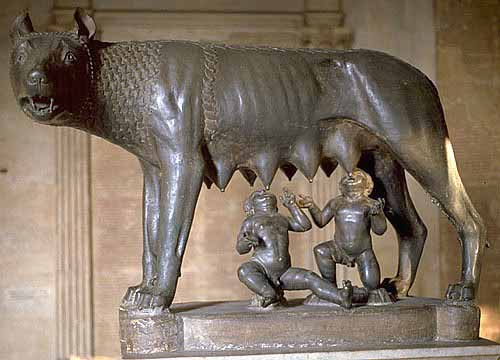
The Romans had a life like ours. They ate food and wore clothes. They lived in houses and had ceremonies. The Romans had a society and a government much like ours. In this essay we will visit the daily life of ancient Rome.
First we will start with the living conditions of Rome. The Romans lived in homes the stretched from the smallest apartment to the biggest mansion. There was a home called a domus which is like a town home. This was a single family home built around a big hall. The size of the home showed others how wealthy or not the owners were. The bigger homes would have a living room, bedrooms, kitchen, bathroom and a reception room. The even wealthier would have a bathtub or a library. There were also apartments. These apartment would reach a few floors off the ground. These came around in the 1st century B.C. There were more apartments then town homes and the apartments stayed the main type of home for Romans until the end of the century.
Next we have the Romans style of clothing. There are three different types of clothing that we will observe today. The men's clothing, women's clothing, and shoes. The toga is what the men usually wore. It was an expensive piece of clothing that was worn especially in public places. The women of Rome wore what are called tunics. The women wore makeup and did their hair how they pleased. As for children they wore miniature clothing of what the adults wore. The shoes of the Romans were different styles of leather shoes. Sandals and boots were worn as well.
There were two types of very important Roman ceremonies. They were the naming of a baby and marriage. The naming of a baby was very important to the Romans. This was the day where they could hand down a name that was in their family to their child. This was a very joyous ceremony. Marriage was another very important ceremony. The man and woman had to be Roman citizens to wed and they had to make their marriage known in order for the children to be legalized.
The Romans had a very well balanced diet. The meals for most Romans was centered around, grain, oil, and wine. If you were richer than you ate better. Fish and oysters were on a high demand. The Romans obviously loved wine but when they drank it they watered it down and heated it. They also put spice in it.
In conclusion the Romans led a life like ours. They just didn't have a lot of the modern conveniences like we do. Our daily life is a lot like the Romans daily life.
First we will start with the living conditions of Rome. The Romans lived in homes the stretched from the smallest apartment to the biggest mansion. There was a home called a domus which is like a town home. This was a single family home built around a big hall. The size of the home showed others how wealthy or not the owners were. The bigger homes would have a living room, bedrooms, kitchen, bathroom and a reception room. The even wealthier would have a bathtub or a library. There were also apartments. These apartment would reach a few floors off the ground. These came around in the 1st century B.C. There were more apartments then town homes and the apartments stayed the main type of home for Romans until the end of the century.
Next we have the Romans style of clothing. There are three different types of clothing that we will observe today. The men's clothing, women's clothing, and shoes. The toga is what the men usually wore. It was an expensive piece of clothing that was worn especially in public places. The women of Rome wore what are called tunics. The women wore makeup and did their hair how they pleased. As for children they wore miniature clothing of what the adults wore. The shoes of the Romans were different styles of leather shoes. Sandals and boots were worn as well.
There were two types of very important Roman ceremonies. They were the naming of a baby and marriage. The naming of a baby was very important to the Romans. This was the day where they could hand down a name that was in their family to their child. This was a very joyous ceremony. Marriage was another very important ceremony. The man and woman had to be Roman citizens to wed and they had to make their marriage known in order for the children to be legalized.
The Romans had a very well balanced diet. The meals for most Romans was centered around, grain, oil, and wine. If you were richer than you ate better. Fish and oysters were on a high demand. The Romans obviously loved wine but when they drank it they watered it down and heated it. They also put spice in it.
In conclusion the Romans led a life like ours. They just didn't have a lot of the modern conveniences like we do. Our daily life is a lot like the Romans daily life.

